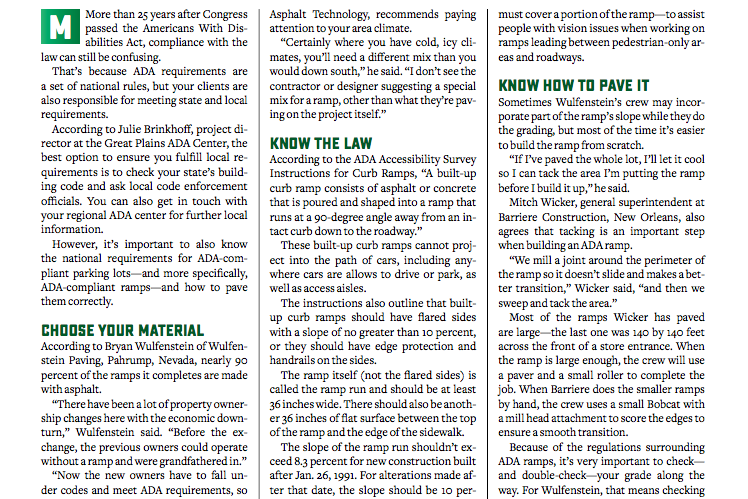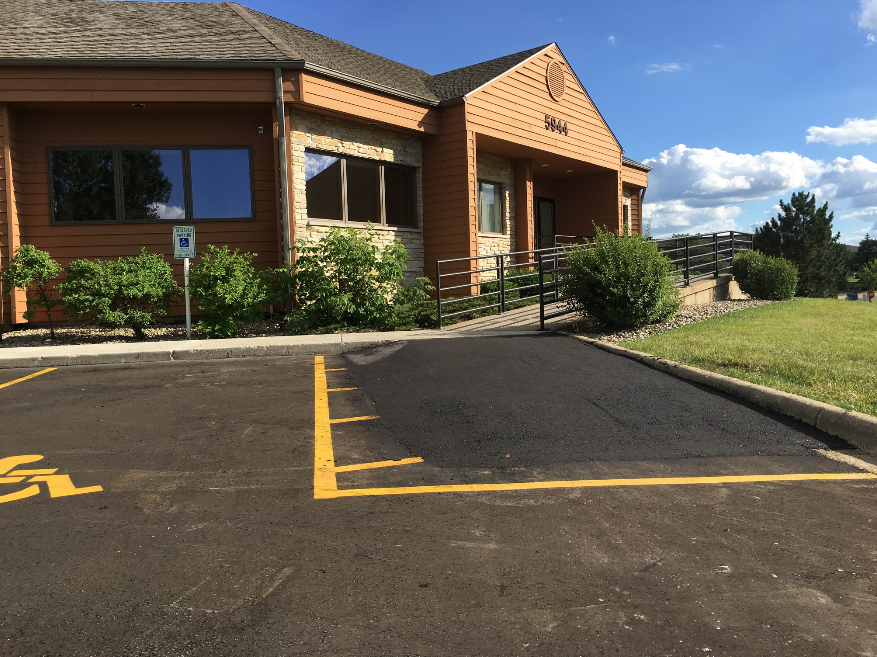How to Pave Asphalt Curb Ramps Correctly
BY AsphaltPro Staff

How to pave asphalt curb ramps correctly
More than 25 years after Congress passed the Americans With Disabilities Act, compliance with the law can still be confusing.
That’s because ADA requirements are a set of national rules, but your clients are also responsible for meeting state and local requirements.
According to Julie Brinkhoff, project director at the Great Plains ADA Center, the best option to ensure you fulfill local requirements is to check your state’s building code and ask local code enforcement officials. You can also get in touch with your regional ADA center for further local information.
However, it’s important to also know the national requirements for ADA-compliant parking lots—and more specifically, ADA-compliant ramps—and how to pave them correctly.
Choose Your Material
According to Bryan Wulfenstein of Wulfenstein Paving, Pahrump, Nevada, nearly 90 percent of the ramps it completes are made with asphalt.
“There have been a lot of property ownership changes here with the economic downturn,” Wulfenstein said. “Before the exchange, the previous owners could operate without a ramp and were grandfathered in.”
“Now the new owners have to fall under codes and meet ADA requirements, so we’re having to build ramps into those existing properties,” Wulfenstein said. “Lots of times they don’t want to spend the money on concrete so we do it out of asphalt.”
The decision of whether to make the ramp out of concrete or asphalt of course must consider cost, but Wulfenstein said it also depends on the layout of the job. Although many curb ramps may be built into the sidewalk, sometimes you may be constructing a built-up curb ramp leading to the sidewalk.
“If we’re doing the ramp within the sidewalk, it’ll probably be made out of concrete,” he said. “If we’re building one up to the sidewalk, we make it out of asphalt.”
When it comes to selecting a mix to construct an ADA ramp, Michael Heitzman, assistant director at the National Center for Asphalt Technology, recommends paying attention to your area climate.
“Certainly where you have cold, icy climates, you’ll need a different mix than you would down south,” he said. “I don’t see the contractor or designer suggesting a special mix for a ramp, other than what they’re paving on the project itself.”

The access aisle located next to accessible parking spaces must be at least 60 inches wide with a slope no greater than 1:50. It must be the same length as the parking spaces it serves, and the ramp must not extend into the access aisle. You can see that the ramp in this picture has been constructed incorrectly.
Know the Law
According to the ADA Accessibility Survey Instructions for Curb Ramps, “A built-up curb ramp consists of asphalt or concrete that is poured and shaped into a ramp that runs at a 90-degree angle away from an intact curb down to the roadway.”
These built-up curb ramps cannot project into the path of cars, including anywhere cars are allows to drive or park, as well as access aisles.
The instructions also outline that built-up curb ramps should have flared sides with a slope of no greater than 10 percent, or they should have edge protection and handrails on the sides.
The ramp itself (not the flared sides) is called the ramp run and should be at least 36 inches wide. There should also be another 36 inches of flat surface between the top of the ramp and the edge of the sidewalk.
The slope of the ramp run shouldn’t exceed 8.3 percent for new construction built after Jan. 26, 1991. For alterations made after that date, the slope should be 10 percent or less for a 6-inch rise or 12.5 percent or less for a 3-inch rise. There are also rules regarding slope across the width of the ramp—the cross slope—which may not exceed 2 percent.
Although getting the grade of the ramp itself is important, the area around the ramp is also subject to regulations. The pavement leading up to the start of the ramp cannot slope more than 5 percent, and the transitions of the ramp at the top and bottom must be flush with surrounding pavement—no abrupt level changes allowed.
According to the ADA instructions, curb ramps have to be located somewhere they won’t be obstructed by parked vehicles.
Detectable warnings—those dome-shaped bumps you are likely familiar with—must cover a portion of the ramp—to assist people with vision issues when working on ramps leading between pedestrian-only areas and roadways.
Know How to Pave It
Sometimes Wulfenstein’s crew may incorporate part of the ramp’s slope while they do the grading, but most of the time it’s easier to build the ramp from scratch.
“If I’ve paved the whole lot, I’ll let it cool so I can tack the area I’m putting the ramp before I build it up,” he said.
Mitch Wicker, general superintendent at Barriere Construction, New Orleans, also agrees that tacking is an important step when building an ADA ramp.
“We mill a joint around the perimeter of the ramp so it doesn’t slide and makes a better transition,” Wicker said, “and then we sweep and tack the area.”
Most of the ramps Wicker has paved are large—the last one was 140 by 140 feet across the front of a store entrance. When the ramp is large enough, the crew will use a paver and a small roller to complete the job. When Barriere does the smaller ramps by hand, the crew uses a small Bobcat with a mill head attachment to score the edges to ensure a smooth transition.
Because of the regulations surrounding ADA ramps, it’s very important to check—and double-check—your grade along the way. For Wulfenstein, that means checking the grade with a smart level while building the ramp, as well as before and after rolling.
Heitzman also noted that proper compaction on asphalt ramps—as with any project—is key.
“If the ramp is compacted properly, no stones will be higher than the rest of the surface,” he said. “Chip seals and other types of products could have stones exposed on the surface, but not hot mix asphalt.”
Wulfenstein’s crew tamps the edges with either a hand tamp or a plate compactor and will often perform a fog seal to prevent raveling.
“The real key to paving ADA-compliant ramps with asphalt is attention to detail,” he said. “You don’t want to have to go back.”
